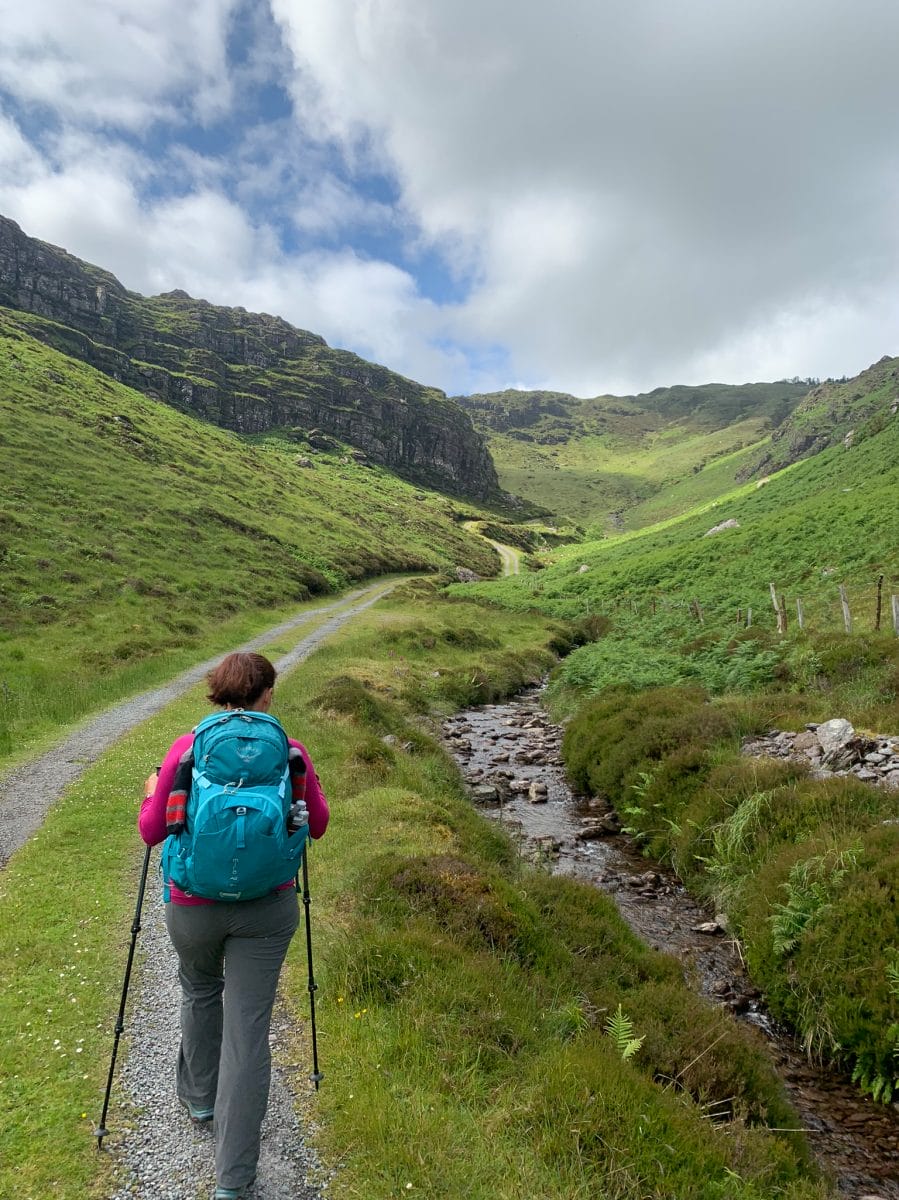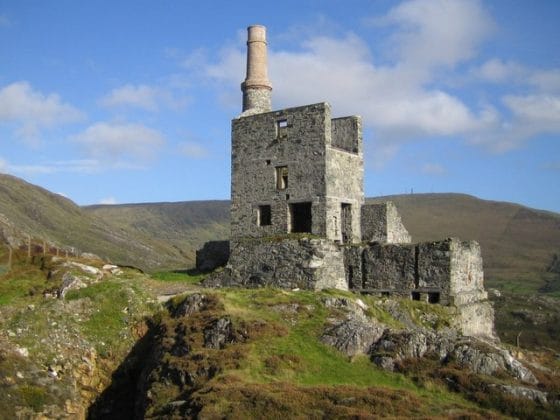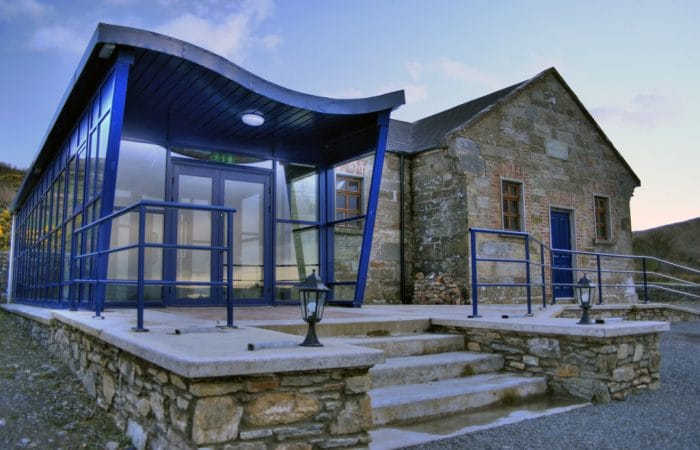There are traces of ancient times to be found all over the Beara Peninsula and while on the Ring of Beara. In this blog post, we introduce some of the key landmarks and the history of the local area.
As well as the Ring of Beara Driving route, these majestic and diverse landscapes can also be discovered while hiking the Beara Way. The various sections of both routes that circle the peninsula offer a unique glimpse into significant periods of Irish history.
If you are looking for more general information on the Beara Way, you can find it here.

The Drombohilly Stone Circle
Historians estimate that the stone circles found in Ireland were erected between 3000 and 1500 BC. This makes them some of the oldest monuments that today bear witness to ancient civilizations on the Emerald Isle.
It is believed that the stone circles served ceremonial and religious purposes. Often the central stone marks the position of the rising or setting sun at the equinox or solstice.
The well-preserved Drombohilly stone circle can be found on the Beara Way near Kenmare. If driving the Ring of Beara, it’s more tricky to find but you can park at Gowlaur Lough. From there, you can take a shorter but less obvious, cross country, hike to Drombohilly stone circle.

The history behind the Beara name
According to legend, the Beara Peninsula was named after a woman. Beara was the name of the wife of the chief Eoin Mór (Eoin the Great). Before the colonization by the English, the Irish population was mainly organized into clans led by chiefs.
1602: The escape of the O’Sullivan Beara clan
One of the most tragic and famous marches in Irish history began on New Year’s Day in 1602. Donal Cam O’Sullivan Beara had fought the English troops for years. After the Battle of Kinsale in 1601, he had to give up the defense of the Beara coast. The siege of Dunboy Castle, an important base, left him and his followers threatened with starvation. He therefore decided to flee north to Leitrim to join up with allies there.
Four hundred soldiers and six hundred relatives, including women and children, fled with him. The English soldiers pursued them relentlessly on the 400 kilometer (249 mile) route while they were fleeing.
The harsh winter, food shortages and raids by the English and other clans meant that only 35 of the total of 1,000 people arrived in Leitrim.
The 500km (311 mile) long Beara Breifne Way today commemorates that march that began in Glengarrif. The entire Beara Way counts as the first stage on this long-distance hiking trail following in the historical footsteps of the O’Sullivan clan.

Bere Island becomes a military base
With the establishment of English rule in the south-west of Ireland, military installations were also built. The English build the majority of their infrastructure at strategically important points, including watchtowers, forts and ports.
The enchanting Bere Island had already been used as a naval base during the siege of Dunboy Castle. It then remained an important base for the English navy for many years afterwards. In 1922, under the terms of the Anglo-Irish Treaty that followed the Irish War of Independence, the British withdrew their present from the majority of Ireland. However, three deep water ports, at Berehaven, Queenstown (renamed Cobh), and Lough Swilly, were retained as sovereign bases until 1938.

1796: Wolf Tone does not land in Bantry Bay
In the fight against the English, Irish leaders like Wolf Tone sought support abroad. He actually managed to mobilize 44 ships from the French Navy in 1796. France, who had recently gained it’s own independence, hoped to weaken England in this way and to keep important war resources away from the continent.
But, as is so often the case, the weather affected the history of Ireland. The worst storms of the 18th century prevented the fleet from landing in Bantry Bay. As tragic as this was for the Irish resistance, this meteorological coincidence was incredibly favorable for the unprepared English.

1812: The Allihies Copper Mine
In 1812 a copper mine was discovered near the Irish village of Allihies. This led to a real copper boom in the area.
The Puxley family had previously received the O’Sullivan clan’s land rights and set about building a copper mine. And so the industrial revolution finally made its way to one of the most rural and remote areas of Ireland.
The mine employed more than 1,500 people at it’s high in 1845 before it suffered due to the arrival of the Great Famine. However, it remained operational until 1962, when it finally closed. A museum, housed in the former church of the miners, is now a reminder of their lives and the very difficult conditions that they worked in.

1845-1852: The Great Famine and an Empty Island
The Great Famine is considered to be one of the saddest chapters in Irish history. The potato rot destroyed the harvests for three years in a row. A mixture of political factors and a heavy reliance on the potato for food resulted in a million people dying. Another million emigrating.
Entire stretches of landscape were depopulated. Bere Island is such an example. Today only 210 people live on the 11 x 5 kilometer island where 2,000 lived before the arrival of the famine. The Bere Island Heritage Center has captured the island’s history and traditions and is open to visitors daily from 9 a.m. to 5 p.m.

Today: Tourism and Film Inspiation
Repeatedly, armed conflicts have determined life on the Beara Peninsula. In 2003, five descendants of the Sullivans were honored by the US military. A US Navy ship visited Bantry Bay to commemorate the death of the five Sullivan brothers. They had all been serving on the same submarine during World War II when it was sunk.
The story of this famous family even inspired the movie Saving Private Ryan.
Nowadays, life is peaceful amidst the breathtaking landscapes along the Ring of Beara and Beara Way routes. The economy is mainly based on agriculture, fishing and tourism, and there is even a meditation center located here.
But if you know the signs to look for, you will still find unique traces of the fascinating history of the Beara Peninsula all around you.



